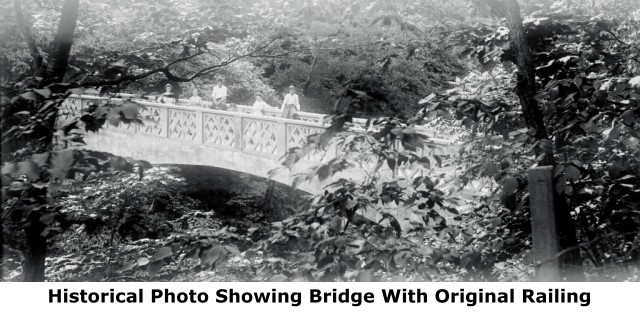We Recommend:
Bach Steel - Experts at historic truss bridge restoration.
BridgeHunter.com Phase 1 is released to the public! - Visit Now
Matthiessen State Park Bridge 3

Primary Photographer(s): Nathan Holth
Bridge Documented: April 13, 2013
Rural: La Salle County, Illinois: United States
1905 By Builder/Contractor: Roemheld and Gallery, and German-American Concrete Co. and Engineer/Design: Strauss Bascule Bridge Company (Strauss Engineering Company) of Chicago, Illinois
Not Available or Not Applicable
72.0 Feet (21.9 Meters)
95.0 Feet (29 Meters)
4.5 Feet (1.37 Meters)
1 Main Span(s)
Not Applicable

View Information About HSR Ratings
Bridge Documentation
View The Patent For This Bridge Design
View A Historical Article About This Bridge
This bridge was built to carry a park path over an impressive rocky gorge. Built in 1905, the bridge is an early surviving example of a concrete arch bridge in Illinois. What makes this bridge highly significant however is that it was designed by famous engineer Joseph Strauss. Strauss ran a consulting engineering company that was originally called the Strauss Bascule and Concrete Bridge Company, and around 1910 was renamed the Strauss Bascule Bridge Company, and later became the Strauss Engineering Company. As the name changes suggest, Strauss initially included concrete bridges among his areas of focus, but later changed his focus to just bascule bridges, moving away from concrete bridges as a major focus of his work. In the early 1900s, concrete was a somewhat novel material for use in bridge building, and Strauss may have initially thought that he should be involved with this new material. Typical of Strauss, he was not content to stick to standard designs and instead developed a variation of a typical concrete arch bridge and quickly patented it to protect his design and enable him to market his bridges as something unique that you could not get from other engineers. His design was a closed spandrel ribbed arch that featured two ribs, with articulated floor beams in between. A 1905 company advertisement features a photo of the Matthiessen State Park Bridge and also mentions that another bridge, a rail bridge, was under construction at the time. This bridge and the rail bridge are the only known examples of this Strauss bridge design that were built. As such, this bridge is historically and technologically significant as a rare surviving example of a patented bridge design created by a famous bridge engineer. The bridge superstructure retains good historic integrity, but the original railings have been replaced. Next to the bridge is an elaborate concrete stairway that leads down to the bottom of the gorge. Unlike the bridge, this stairway has original railings, and they appear similar to the original railings on the bridge. It is not known if Strauss also designed the stairway. It is a rather complex structure, built right into the rocky cliff, and composed a series of flights with several aspects of cantilever in the design of the concrete. It might have made Frank Lloyd Wright proud!
![]()
Photo Galleries and Videos: Matthiessen State Park Bridge 3
Bridge Photo-Documentation
Original / Full Size PhotosA collection of overview and detail photos. This gallery offers photos in the highest available resolution and file size in a touch-friendly popup viewer.
Alternatively, Browse Without Using Viewer
![]()
Bridge Photo-Documentation
Mobile Optimized PhotosA collection of overview and detail photos. This gallery features data-friendly, fast-loading photos in a touch-friendly popup viewer.
Alternatively, Browse Without Using Viewer
![]()
Maps and Links: Matthiessen State Park Bridge 3
Coordinates (Latitude, Longitude):
Search For Additional Bridge Listings:
Bridgehunter.com: View listed bridges within 0.5 miles (0.8 kilometers) of this bridge.
Bridgehunter.com: View listed bridges within 10 miles (16 kilometers) of this bridge.
Additional Maps:
Google Streetview (If Available)
GeoHack (Additional Links and Coordinates)
Apple Maps (Via DuckDuckGo Search)
Apple Maps (Apple devices only)
Android: Open Location In Your Map or GPS App
Flickr Gallery (Find Nearby Photos)
Wikimedia Commons (Find Nearby Photos)
Directions Via Sygic For Android
Directions Via Sygic For iOS and Android Dolphin Browser
USGS National Map (United States Only)
Historical USGS Topo Maps (United States Only)
Historic Aerials (United States Only)
CalTopo Maps (United States Only)



